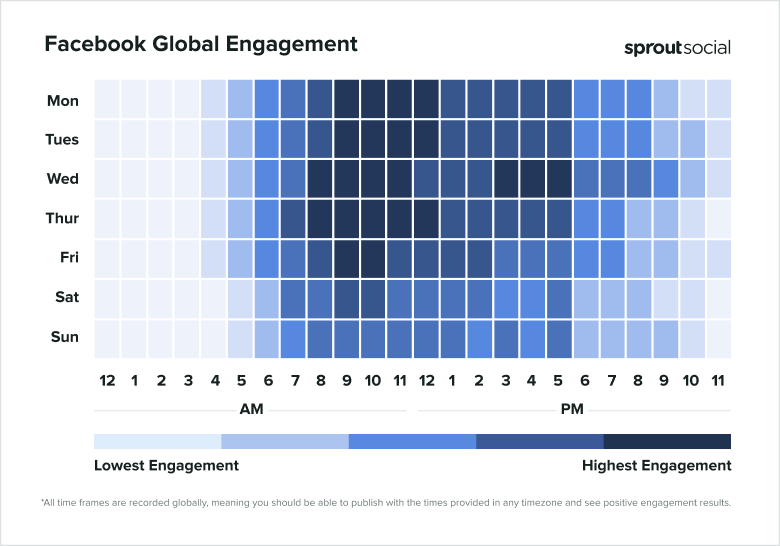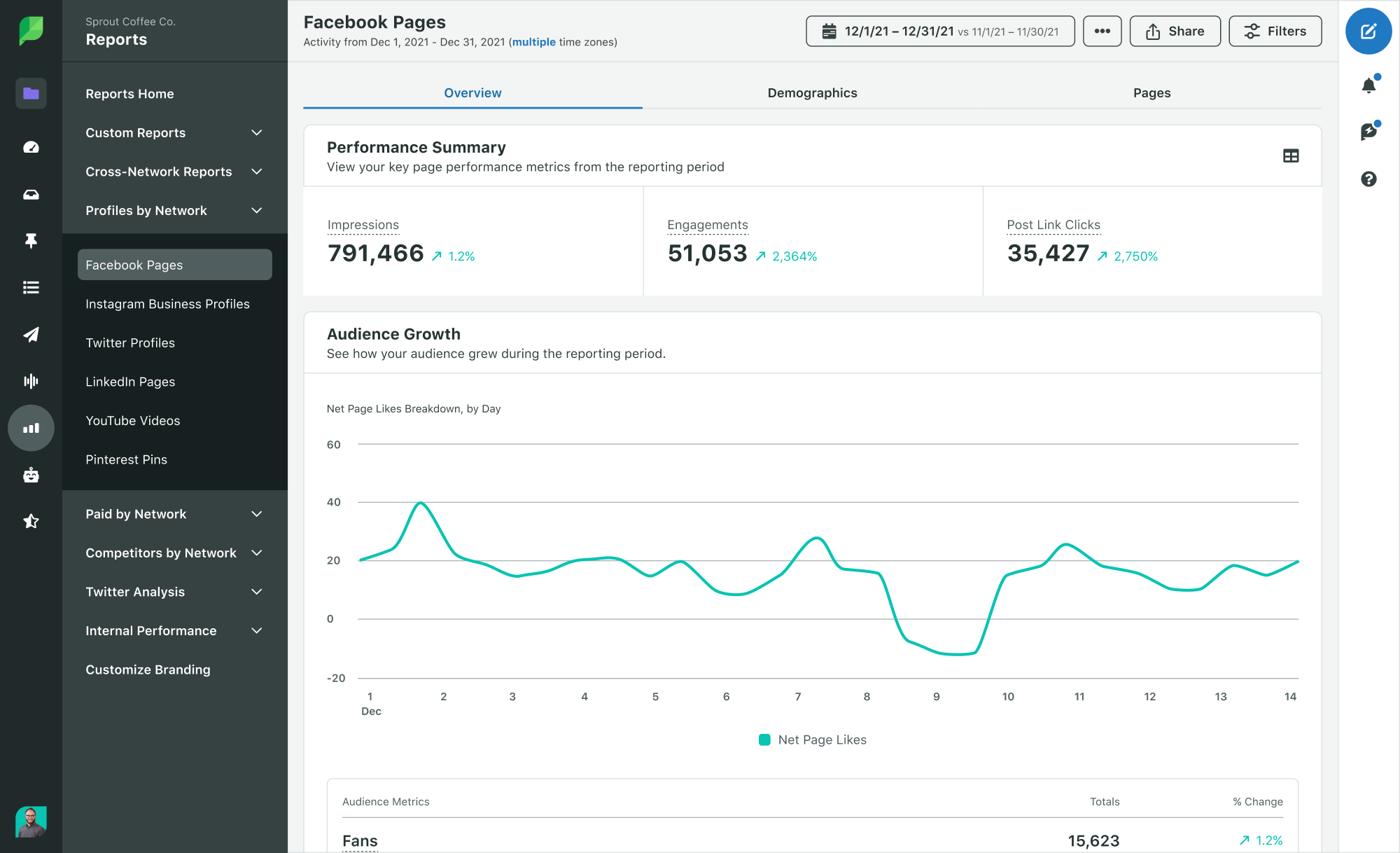A Facebook audit evaluates your Page’s performance, branding consistency and strategic alignment in 30 minutes or less. Facebook updates features constantly, making regular audits essential for maintaining brand standards and maximizing business impact.
A comprehensive social media audit identifies optimization opportunities and guides your Facebook marketing strategy improvements.
This complete Facebook audit covers five essential areas:
- Profile and branding: Foundation elements and first impressions
- Content and audience: Performance analysis and targeting accuracy
- Audit tools: Platforms and automation for efficiency
- Advertising effectiveness: Campaign performance and ROI analysis
- Strategic alignment: Goal measurement and optimization opportunities
Open up your Facebook Page and get ready for the audit!
Before you begin, download our social media audit template to stay organized.
1. Facebook profile and branding audit
A Facebook profile audit examines five critical elements: profile completion, CTA functionality, SEO optimization, visual branding and customer service setup. First impressions drive engagement, making this foundation audit essential for business success.
Profile completion
Review your profile from multiple viewpoints to identify inconsistencies Facebook’s algorithm shows different users. Check these three perspectives:
- Logged-out view: Open private browser window to see public-facing version
- Personal profile view: Use account toggle to see logged-in user experience
- Business view: Review from your business account perspective
To demonstrate this, we’ll use Bloomscape as an example. The light background shows what people see if they’re not logged into Facebook while the dark background appears to users who are logged in. The arrangement of tabs and content is different between the two.


Once you’ve reviewed your profile, head to the Settings menu. Working your way from top to bottom, click through each setting menu tab to ensure all the necessary fields are completed.
CTA button, links and custom username
Go back to your profile page and look at your CTA button located on the bottom-right corner of your cover photo. Ensure the CTA is still accurate with a working link or change it to a new action.
Now click on your About tab and make sure all the links and contact info is still accurate. Customers visit the About tab to learn more about your brand and check your hours.
SEO check and verification
If you think that what you write into your Page doesn’t matter, think again. Run a brand name search on Google to see what shows up.
Continuing with Bloomscape as an example, after Googling their brand name, the first page of the search results features their social media profiles from their Instagram and Facebook accounts.

Also, if the option is available, complete the verification process in Business Manager to get a blue checkmark next to your profile name and assure customers they’re on the right brand Page.
Cover photo and profile photo
In the two areas where media shows up prominently on your profile, it’s important to put your best branding foot forward. The profile photo is usually where your logo goes. Use a simple version of your logo so it’s recognizable in all formats.
Your cover photo doesn’t need to be static. Videos are a fun way to introduce your brand and be eye-catching. The dimensions must be at least 400 x 150 pixels.

Customer service
Customer expectations for social media interactions continue rising, making proactive customer care setup essential. Navigate to Messaging Settings in your Page menu to configure greetings and Messenger URLs that streamline customer communication.
If you want to explore further, go to your Business Suite Inbox to set up automated responses and Away messages. With an active Facebook Page, use a service like Sprout Social’s customer care solutions to manage comments, reviews and messages all in one place.
Tips
- Learn how to use Facebook and build your Facebook business Page to attract customers.
- Understand how SEO matters in social media.
- Optimize your Facebook cover photo with the best dimensions and file types.
2. Facebook content and audience audit
In this second part of the Facebook audit, we look at what your general content looks like and if it’s serving the right audience for you. Be sure to look at all the Facebook features such as Stories and Live for the most comprehensive audit.
Overall color and feel
Scroll through your Facebook profile page to get an idea of your brand’s visual presence on the platform. For the posts that contain media like photos and videos, ask yourself if they’re on brand. Do the right brand colors stand out? Is there a cohesive feel to the posts?
Image sizing and optimization
We mentioned earlier about optimizing your cover photo. Now it’s time to look at your posts. Optimizing your images for Facebook means that they’ll display well no matter what device your audience is using. Check out the always up-to-date guide for the latest Facebook specs.
Serving the right audience
Facebook Insights shows your audience’s demographic data. This data shows if your current audience matches your target audience.
Sometimes, the two are different. If your marketing strategy aims to reach one target audience but data on your Facebook Insights is different, then there’s an issue.

Captions
Let’s move on to the written portion of your posts. What you write in those first few lines is what grabs your audience’s attention.
Use different post ideas to keep your audience engaged and interested.
In this fun post, Oreo keeps the caption simple but effective. The image catches your eye first, but the caption makes you stop and search for the four cookies that are different.

Hashtags and tagging
Look at your posts again and this time around, observe your use of Facebook hashtags and tagged Pages. Keep hashtags relevant and limited.
And when you’re mentioning other brands, tag them so they see the post and engage with it. It creates social goodwill between brands and encourages post engagement.
Tips
- Check your profile for visual brand cohesiveness
- Don’t limit yourself to only posts. Take advantage of the different post types and features that Facebook offers.
- Check your audience demographic to measure brand awareness
3. Tools for streamlining your Facebook audit
Manual audits consume hours of valuable strategy time. Smart marketers automate data collection and centralize insights for faster decision-making.
Transform your audit process with comprehensive social media management tools:
| Audit Component | Manual Process | Sprout Social Solution |
|---|---|---|
| Post Performance | Export multiple CSV files | Facebook Reports with visual analytics |
| Ad Performance | Navigate multiple ad dashboards | Paid Performance Report with ROI tracking |
| Customer Interactions | Check comments, messages separately | Smart Inbox centralizes all interactions |
| Data Analysis | Hours of spreadsheet work | Automated insights and recommendations |
This integrated approach transforms audit tasks into strategic insights without platform switching.
4. Facebook ads audit
Facebook advertising drives measurable business results when executed strategically. Whether you’re evaluating existing campaigns or planning your first ads, this audit reveals optimization opportunities that impact your bottom line.
Performance review
Benchmarking your Facebook ad performance will depend on your industry and campaign objective. These metrics provide information for calculating your Facebook advertising cost and ROI.
Run a search for your most recent ads or use Sprout Social’s Facebook and Instagram Paid Performance Report in the Performance review section. Compare these to your industry benchmarks to see how you match up.

Creatives
Spend enough time on Facebook and you’ve probably seen the same ad from the same brand multiple times. During this audit, examine your current creatives. Take note of campaigns that are running too long, especially if engagement drops by the month, which means your audience is losing interest.
And while we’re here, check that your ad sizes and specs are optimized for the placements you chose. An ad that crops out your product won’t be very effective.
Accurate targeting and audiences
If you’ve got your ads set up with the best creatives, you want them to reach the right people. Look into your targeting details and see if the target audience is the one seeing and engaging with the ad.
Create different audiences to spread brand awareness and avoid ad fatigue. Use a lookalike audience to find people similar to your existing audiences.

Tips
- Use this foolproof method to create your Facebook ad strategy
- Don’t let your ads become stale. Get inspired by these ad campaigns.
- Are you targeting the same audience too often? Use lookalike audiences in your next ad campaign.
5. Facebook strategy audit
We’re in the final stretch of the Facebook audit and it’s an important one. Without an effective Facebook marketing strategy, your resources aren’t being used wisely. This is where more detailed metrics come into play.
Scheduling
According to Sprout Social’s data, the best times to post on Facebook are Mondays through Thursdays between 8 a.m. and 1 p.m., generally. This is an aggregated data set, so your best times will differ from the graphic below.

Analyze post-level engagement data to identify your optimal posting windows. Compare your current schedule against peak engagement times.
Scheduling audit checklist:
- Peak engagement hours: Identify your top three to five performing time slots
- Day-of-week patterns: Note which days drive highest interaction rates
- Content type timing: Match post types to optimal scheduling windows
Engagement
At the post level, you’ll need to review what your engagement rate is like and how your target audience is engaging. Some posts have more comments than others. Is there a correlation between your most commented posts?
Sprout Social’s Facebook Reports in the Engagement section provides you with easy-to-read charts so you know exactly what your engagement level is like.

The other part of engagement is how you’re interacting with others. Are you answering questions in the comments?
Influencers
Using influencers as part of your overall marketing strategy is common for brands. At a glance, are the influencers you’re currently working with still useful to your brand?
See if conducting an audit on your influencer strategy will identify if you are reaching your target goals and if there are ways you can improve upon it. While it takes time, finding the right influencers for your brand results in a mutually beneficial relationship that benefits your bottom line.
Goal alignment
Every strategy needs some goals to measure its success. In this final portion of the audit, see if your current Facebook strategy matches up with your social media goals. If this year’s goals are to increase brand awareness, then your posts and analytics must reflect that.
Takeaway
- Use Sprout Social’s ViralPost scheduling feature to publish at optimal times.
- Track the right metrics for your goals in your analytics.
- Use these strategies to increase falling engagement.
6. Next steps for your Facebook audit
An audit is useless without action. You’ve identified the problems, but the real work starts now. It’s time to turn your findings into a clear roadmap for improvement.
The most successful brands on social don’t just find issues; they fix them. Prioritize the most critical fixes from your audit, assign ownership to your team and set clear deadlines for implementation.
Use a platform like Sprout Social to execute your new strategy and track performance improvements over time. See exactly how your changes impact your goals. Start your free trial to explore how our tools transform audit insights into business results.
The post How to do a Facebook audit in 30 minutes or less appeared first on Sprout Social.

